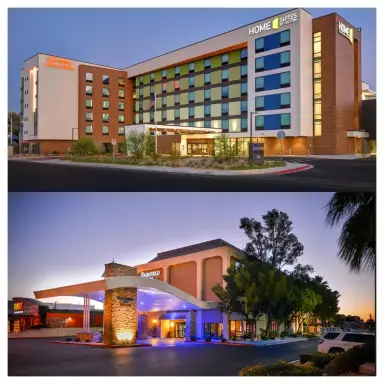
The brochure and pamphlet, two commonly used marketing tools, each play a vital role. Each has its unique designs and purpose, making them indispensable for these events like expos and trade shows. The real difference between a brochure vs pamphlet often lies in the subject matter, the number of pages, and the way they’re used.
Both these marketing materials can be seen in abundance at trade shows. They are designed to catch the eye of the target audience and provide detailed information about the company’s products or services. Choosing between a brochure or pamphlet is a key decision to make, one that can directly impact your marketing campaigns.
What Is a Brochure?
A brochure is a form of folded paper or bound multi-page booklet often used as a marketing tool. It contains images, illustrations, and text providing detailed information about a company’s products or services.
Purpose
A brochure’s main purpose is to act as a marketing brochure, designed to inform and persuade potential customers. It can focus on a new product, highlight individual products, or present an overview of the company’s products. Brochures are often utilized in marketing campaigns, designed to boost brand awareness and influence purchasing decisions.
Size
Brochures come in different shapes and sizes, with the typical sizes usually ranging from 8.5 x 11 inches for a single page or bi-fold brochure to larger formats for tri-fold brochures and small booklets. The page length and number of pages will depend on the subject matter and the amount of information you wish to convey.
| ● Tri-Fold Brochure (8.5″ x 11″) ● Bi-Fold Brochure (8.5″ x 11″) ● Square Brochure (various sizes such as 6″ x 6″, 8″ x 8″, or 10″ x 10″) |
Style
Brochures have a professional and sleek style. They often feature unique designs, high-quality graphics, and eye-catching layouts to entice readers. From single subject brochures to multi-page booklets, their style is often tailored to the target audience and the marketing purposes they serve.
Design or Layout
A brochure’s design or layout is more complex than a pamphlet. It can be a single page, bi-fold, or tri-fold brochure, each with its own unique layout. The design usually incorporates the company’s branding, including logos, color schemes, and fonts. Often, marketers will use a brochure template to ensure consistency and professionalism.
| Types | Structures | Features |
| Bi-fold brochures | a single sheet of paper is folded in half, creating four panels | • Simplicity: It has a simple structure that is easy to design and read. • Versatility: It can be used for a wide range of promotional purposes. • Space: It offers enough space for detailed information and imagery. • Display: It opens flat, allowing a large, impactful design or image across the center spread. |
| Trifold brochure | a single sheet of paper is folded twice to create six panels | • Organization: It allows for clear segmentation of information into different sections. • Compact: It’s compact when folded and opens up to provide a large amount of information. • Versatility: It’s great for mailing, handing out at events, or displaying on brochure racks. • Space: More panels mean more space for information and graphics. |
| Z-fold brochure | folds like an accordion or Z-shape, with each panel displaying a standalone bit of information | • Segmentation: Each panel can stand on its own, conveying a unique aspect of the information. • Display: It unfolds all at once, which can have a strong visual impact. • Flow: The reader can follow the information in a chronological or step-by-step sequence. • Versatility: It can be used in presentations, mailings, and displays like other brochures but offers a different visual experience. |
Price
Due to their complex design, high-quality printing, and glossy paper, brochures are typically more expensive to produce than pamphlets. However, they also tend to have a greater impact on customers due to their detailed content and attractive design.
Paper
Brochures are usually printed on high-quality, thick, and often glossy paper, enhancing their look and feel. This quality makes them a more durable and long-lasting marketing material, capable of withstanding the hustle and bustle of trade shows and other marketing events.
What Is a Pamphlet?

A pamphlet is a small, unbound booklet that is usually more concise and focuses on a single subject.
Purpose
The purpose of a pamphlet is to inform its reader about a particular topic, often for non-commercial use. Pamphlets are used widely for educational, political campaigns, and public awareness initiatives. They provide information succinctly and concisely, making them an ideal choice for conveying essential details about a specific event or issue.
| Types | Where to use | Features |
| Civic Pamphlets | • government institutions • non-profit organizations • other civic bodies | • Content: They often contain information about public services, civic duties, rights, and regulations. • Accessibility: They are designed to be simple, clear, and easy to understand, targeting a wide demographic. • Distribution: They are usually distributed freely at public events, offices, through mail, or digitally. • Informative: They tend to be more informative and factual, rather than promotional. |
| Cultural Pamphlets | • cultural institutions like museums, art galleries, theatres, or tourism boards | • Content: They often contain information about art exhibitions, historical landmarks, cultural events, or travel destinations. • Visual Appeal: They are usually colorful and visually rich, designed to capture the spirit of the culture or event they are promoting. • Promotional: They are often used to attract visitors, sell tickets, or increase public participation. • Distribution: They are usually found at tourist information centers, event venues, hotels, or shared digitally. |
| Educational Pamphlets | • educational institutions • researchers • educators | • Content: They often contain detailed information on a specific subject, research data, program information, or educational resources. • Design: They are typically straightforward and focused on clarity and readability. • Purpose: They aim to inform, educate, or guide the reader on a particular topic. • Distribution: They are often distributed in schools, colleges, conferences, libraries, or shared digitally. |
Size
Pamphlets are typically smaller than brochures. Because their main purpose is to grab the reader’s attention and make it easy for them to read. The text is small, but small enough that it has to and speech.
| ● Standard Letter Size (8.5″ x 11″) ● Half-Letter Size (5.5″ x 8.5″) ● DL Size (99mm x 210mm) |
Style
The style of a pamphlet is usually simpler and more straightforward than a brochure. It focuses on delivering clear and concise information, often in a bullet-point format, rather than relying on sophisticated design elements.
Design or Layout
The design or layout of a pamphlet is generally less complex than that of a brochure. A pamphlet template may be used to keep the design consistent. While it may not be as visually appealing as a brochure, the emphasis in a pamphlet is on the content rather than the design.
Price
Pamphlets are a cheap way to disseminate information due to their simplicity and the fact that they’re typically printed on less expensive paper. For organizations with a tight budget, pamphlets offer an effective and cost-efficient way to reach their target audience.
Paper
Pamphlets are typically printed on a single sheet of paper, although they can be folded into a bi-fold or trifold format. The paper used for pamphlets is often lighter and less expensive than glossy paper typically used for brochures.
What Isn’t a Brochure or a Pamphlet?
Though brochures and pamphlets share many similarities, it’s crucial to distinguish them from other printed marketing materials.
Flyers
A flyer, or flier, is another commonly used promotional material. It’s a single piece of paper used to convey a clear and concise message about a specific event, service, or product. The key difference between a flyer and a brochure or pamphlet is its simplicity and transience. Unlike brochures and pamphlets that provide detailed information, flyers are designed for short-term, specific promotions or events and often discarded after reading.
Rack Cards
Rack cards are marketing tools typically found in display racks or holders. They are generally used in locations with high foot traffic like hotels, restaurants, or local events. A rack card’s main difference from a brochure or pamphlet lies in its purpose and design. It is designed to attract immediate attention and encourage impulsive decisions, typically advertising a single service, product, or attraction.
Magazines
Magazines, though also multi-page booklets, serve a different purpose from brochures and pamphlets. While brochures and pamphlets are primarily used for marketing or educational purposes, magazines are periodicals offering a variety of content, such as articles, stories, and photographs, on a wide range of topics.
How to Design an Effective Brochure or Pamphlet?
Designing an effective brochure or pamphlet requires careful planning and execution.
Purpose: Start by determining the purpose-whether you’re creating a brochure for a product booklet or a pamphlet for a political campaign. From there, consider your target audience’s needs and preferences.
Marketing Materials: Your marketing material should be eye-catching, but not at the expense of the clarity of information. Ensure your design is aligned with your brand’s identity, utilizing your brand’s colors, fonts, and styles. Pay attention to the layout, ensuring it’s clean and organized, making it easy for readers to absorb the information.
Graphics and Illustrations: Use high-quality graphics and illustrations to make your material visually appealing. But remember, it’s not just about aesthetics. The key to an effective brochure or pamphlet lies in the quality of its content. Keep it informative, engaging, and persuasive, making sure it adds value to your target audience.
What Are Some Common Mistakes to Avoid When Creating a Brochure or Pamphlet?
When creating a brochure or a pamphlet, it’s crucial to avoid common mistakes that could reduce their effectiveness. These include overloading too much information, using poor quality images, and lacking a clear call to action.
Firstly, avoid the temptation to overload your brochure or pamphlet with too much information. Strive for a balance between informative and engaging content without overwhelming your readers.
Secondly, don’t compromise on the quality of images and graphics. Blurry or pixelated images can reduce the perceived value of your material and reflect poorly on your brand.
Lastly, never forget to include a clear call to action (CTA). Your CTA is the direction you want your readers to take after reading your material, whether it’s visiting a website, making a call, or attending an event.
Conclusion
Understanding the difference between a brochure and a pamphlet is crucial for any marketer. While they share similarities, these marketing materials serve different purposes and offer unique advantages. Remember, an effective brochure or pamphlet doesn’t just look good; it delivers a clear message, aligns with your brand identity, and provides value to your audience. With thoughtful planning and design, both brochures and pamphlets can be powerful tools in your marketing toolkit, whether you’re participating in a trade show, launching a product, or advocating for a cause.
Designing and Printing Your Own Brochures or Pamphlets – Choose Aplusexpo
If you’re planning to design and print your own brochures or pamphlets, choosing Aplusexpo is an excellent decision.
One of their standout offerings is their superior graphics printing capabilities, which is paramount when creating eye-catching brochures or pamphlets. Not only do they ensure high-quality prints, but their expert designers can aid in crafting unique and impactful marketing materials, boosting your brand’s visibility and effectiveness.
Choosing Aplusexpo means opting for excellence, professionalism, and an unwavering commitment to your marketing and exhibition success.






